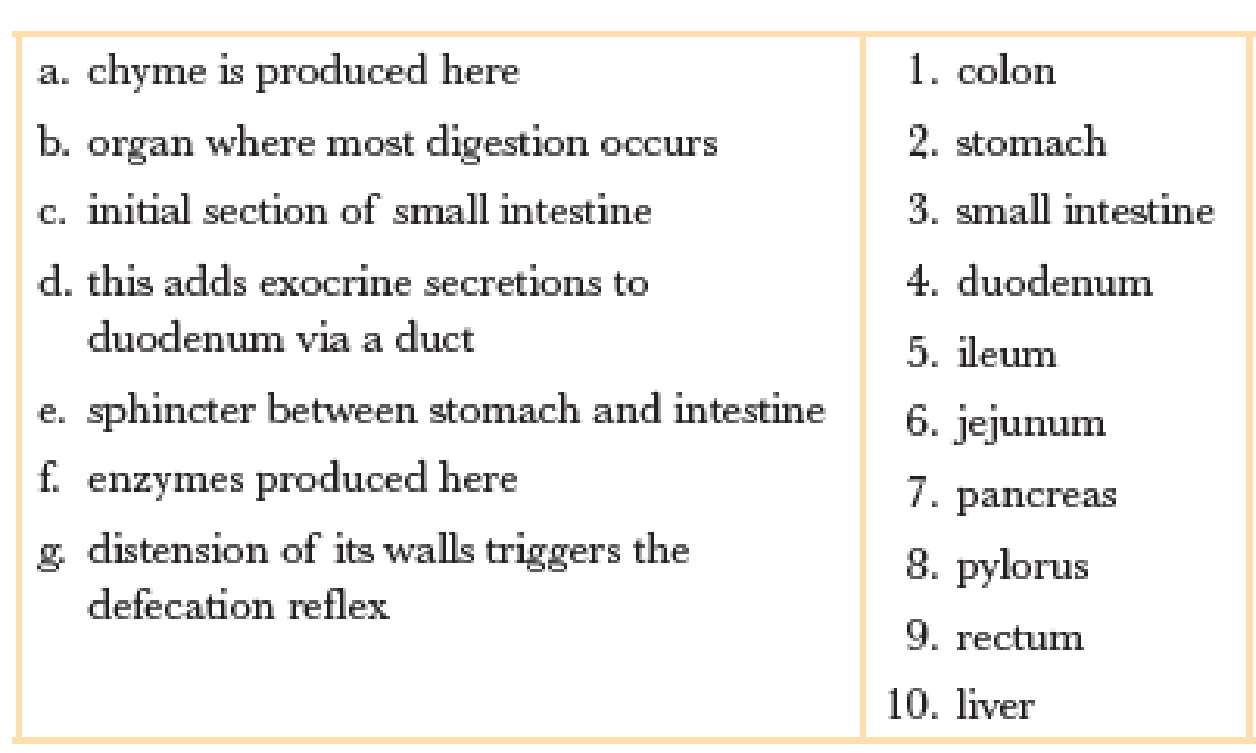
Match each of the following descriptions with the appropriate term(s):

To match: Each description with appropriate term.
Answer to Problem 1RQ
Correct Answer:
| a. Chyme is produced here | 2.stomach |
| b. Organ where most digestion occurs | 3.small intestine |
| c. Initial section of small intestine | 4.duodenum |
| d. This adds exocrine secretions to duodenum via a duct |
7.pancreas, 10.liver |
| e. Sphincter between stomach and intestine | 8.pylorus |
| f. Enzymes produced here |
2.stomach, 3.Small intestine, 7.Pancreas |
| g. Distension of its walls triggers the defecation reflex | 9.rectum |
Explanation of Solution
a. Chyme is produced here- 2. stomach
Chyme is mixture of partly digested food and stomach fluids. The food comes through the esophagus and reaches to stomach. The secretions from the digestive glands reach the stomach, and they form a mixture called chyme.
b. Organ where most digestion occurs- 3. small intestine
The small intestine is the site at which most of the digestion occurs. This is because small intestine provides larger surface area due to the presence of villi.
c. Initial section of small intestine- 4. duodenum
The small intestine is divided into three sections, namely duodenum, jejunum, and ileum. The duodenum is the initial section of the small intestine.
d. This adds exocrine secretions to duodenum via a duct- 7. Pancreas and 10. liver
Pancreas and liver are two accessory glandular organs. The pancreas secretes pancreatic juices and the liver secretes bile. Their secretions enter into the duodenum via ducts.
e. Sphincter between stomach and intestine- 8. pylorus
The pylorus is present between the stomach and small intestine; it acts as a gatekeeper. The movement of the pylorus is guarded by the pyloric valve. The valve is a thickened band of smooth muscle.
f. Enzymes produced here- 2. stomach, 3. small intestine, 7. pancreas
Enzymes are the proteins that break food into an absorbable form. The stomach produces two enzymes, gastric lipase and pepsinogen. The small intestine produces two enzymes, maltase, and peptidases. The pancreas produces proteolytic enzymes such as trypsin and chymotrypsin.
g. Distension of its walls triggers the defecation reflex- 9. rectum
The rectum is the end part of the large intestine that stores undigested food for some time. When the volume reaches up to the level, the defecation reflex occurs. This removes the undigested food from the body in the form of feces.
Want to see more full solutions like this?
Chapter 21 Solutions
EBK HUMAN PHYSIOLOGY
- Ch.21 What causes patients infected with the yellow fever virus to turn yellow (jaundice)? A. low blood pressure and anemia B. excess leukocytes C. alteration of skin pigments D. liver damage in final stage of disease — What is the advantage for malarial parasites to grow and replicate in red blood cells? A. able to spread quickly B. able to avoid immune detection C. low oxygen environment for growth D. cooler area of the body for growth — Which microbe does not live part of its lifecycle outside humans? A. Toxoplasma gondii B. Cytomegalovirus C. Francisella tularensis D. Plasmodium falciparum — explain your answer thoroughlyarrow_forwardCh.22 Streptococcus pneumoniae has a capsule to protect it from killing by alveolar macrophages, which kill bacteria by… A. cytokines B. antibodies C. complement D. phagocytosis — What fact about the influenza virus allows the dramatic antigenic shift that generates novel strains? A. very large size B. enveloped C. segmented genome D. over 100 genes — explain your answer thoroughlyarrow_forwardWhat is this?arrow_forward
- Molecular Biology A-C components of the question are corresponding to attached image labeled 1. D component of the question is corresponding to attached image labeled 2. For a eukaryotic mRNA, the sequences is as follows where AUGrepresents the start codon, the yellow is the Kozak sequence and (XXX) just represents any codonfor an amino acid (no stop codons here). G-cap and polyA tail are not shown A. How long is the peptide produced?B. What is the function (a sentence) of the UAA highlighted in blue?C. If the sequence highlighted in blue were changed from UAA to UAG, how would that affecttranslation? D. (1) The sequence highlighted in yellow above is moved to a new position indicated below. Howwould that affect translation? (2) How long would be the protein produced from this new mRNA? Thank youarrow_forwardMolecular Biology Question Explain why the cell doesn’t need 61 tRNAs (one for each codon). Please help. Thank youarrow_forwardMolecular Biology You discover a disease causing mutation (indicated by the arrow) that alters splicing of its mRNA. This mutation (a base substitution in the splicing sequence) eliminates a 3’ splice site resulting in the inclusion of the second intron (I2) in the final mRNA. We are going to pretend that this intron is short having only 15 nucleotides (most introns are much longer so this is just to make things simple) with the following sequence shown below in bold. The ( ) indicate the reading frames in the exons; the included intron 2 sequences are in bold. A. Would you expected this change to be harmful? ExplainB. If you were to do gene therapy to fix this problem, briefly explain what type of gene therapy youwould use to correct this. Please help. Thank youarrow_forward
- Molecular Biology Question Please help. Thank you Explain what is meant by the term “defective virus.” Explain how a defective virus is able to replicate.arrow_forwardMolecular Biology Explain why changing the codon GGG to GGA should not be harmful. Please help . Thank youarrow_forwardStage Percent Time in Hours Interphase .60 14.4 Prophase .20 4.8 Metaphase .10 2.4 Anaphase .06 1.44 Telophase .03 .72 Cytukinesis .01 .24 Can you summarize the results in the chart and explain which phases are faster and why the slower ones are slow?arrow_forward
- Can you circle a cell in the different stages of mitosis? 1.prophase 2.metaphase 3.anaphase 4.telophase 5.cytokinesisarrow_forwardWhich microbe does not live part of its lifecycle outside humans? A. Toxoplasma gondii B. Cytomegalovirus C. Francisella tularensis D. Plasmodium falciparum explain your answer thoroughly.arrow_forwardSelect all of the following that the ablation (knockout) or ectopoic expression (gain of function) of Hox can contribute to. Another set of wings in the fruit fly, duplication of fingernails, ectopic ears in mice, excess feathers in duck/quail chimeras, and homeosis of segment 2 to jaw in Hox2a mutantsarrow_forward
 Human Biology (MindTap Course List)BiologyISBN:9781305112100Author:Cecie Starr, Beverly McMillanPublisher:Cengage Learning
Human Biology (MindTap Course List)BiologyISBN:9781305112100Author:Cecie Starr, Beverly McMillanPublisher:Cengage Learning- Health Safety And Nutrition F/Young ChildHealth & NutritionISBN:9781305144767Author:MAROTZPublisher:Cengage





